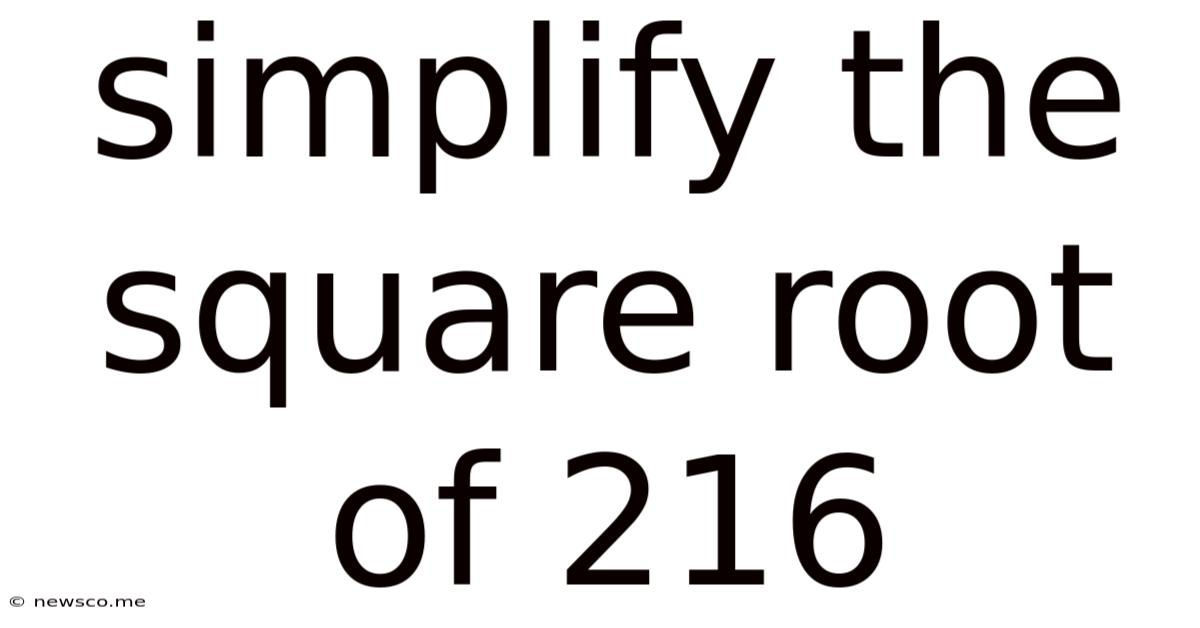Simplify The Square Root Of 216
News Co
Apr 20, 2025 · 4 min read

Table of Contents
Simplifying the Square Root of 216: A Comprehensive Guide
The seemingly simple task of simplifying the square root of 216 (√216) offers a fantastic opportunity to delve into the fundamentals of square roots, prime factorization, and radical simplification. This guide will take you through the process step-by-step, explaining the concepts involved and providing you with the tools to simplify other square roots with ease. We'll explore various methods, ensuring you grasp the underlying mathematical principles and can confidently tackle similar problems.
Understanding Square Roots and Prime Factorization
Before we dive into simplifying √216, let's refresh our understanding of key concepts:
What is a Square Root?
A square root of a number is a value that, when multiplied by itself, gives the original number. For example, the square root of 9 (√9) is 3 because 3 x 3 = 9. Square roots can be whole numbers, fractions, or irrational numbers (numbers that cannot be expressed as a simple fraction).
Prime Factorization: The Key to Simplification
Prime factorization is the process of breaking down a number into its prime factors. Prime numbers are whole numbers greater than 1 that are only divisible by 1 and themselves (e.g., 2, 3, 5, 7, 11...). Prime factorization is crucial for simplifying square roots because it allows us to identify perfect square factors within the number.
Method 1: Prime Factorization and Pair Identification
This is the most common and widely understood method for simplifying square roots.
Step 1: Find the Prime Factorization of 216
We start by finding the prime factorization of 216. We can use a factor tree:
216
/ \
2 108
/ \
2 54
/ \
2 27
/ \
3 9
/ \
3 3
Therefore, the prime factorization of 216 is 2 x 2 x 2 x 3 x 3 x 3, or 2³ x 3³.
Step 2: Identify Pairs of Prime Factors
Now, we look for pairs of identical prime factors. In the prime factorization of 216, we have one pair of 2s and one pair of 3s.
Step 3: Simplify the Square Root
For each pair of identical prime factors, we take one factor out from under the square root symbol. The remaining factors stay inside.
√216 = √(2 x 2 x 2 x 3 x 3 x 3) = √(2² x 3² x 2 x 3) = 2 x 3 x √(2 x 3) = 6√6
Therefore, the simplified form of √216 is 6√6.
Method 2: Using Perfect Squares
This method focuses on identifying perfect square factors of 216. A perfect square is a number that is the square of an integer (e.g., 4, 9, 16, 25...).
Step 1: Find Perfect Square Factors
We need to find perfect square factors of 216. Let's list some perfect squares: 4, 9, 16, 36, etc. We can see that 36 is a factor of 216 (216 / 36 = 6).
Step 2: Rewrite the Square Root
We can rewrite √216 as √(36 x 6).
Step 3: Simplify
Since √(36 x 6) = √36 x √6, and √36 = 6, we have 6√6.
Again, the simplified form is 6√6.
Method 3: A Combination Approach
This method combines elements of both previous methods for a more intuitive understanding.
Step 1: Partial Factorization
Instead of complete prime factorization immediately, let's look for easily identifiable factors. We know 216 is an even number, so it's divisible by 2: 216 = 2 x 108. 108 is also divisible by 2: 108 = 2 x 54. We continue: 54 = 2 x 27; 27 = 3 x 9; 9 = 3 x 3.
So we have 216 = 2 x 2 x 2 x 3 x 3 x 3 = 2³ x 3³.
Step 2: Identify Perfect Squares
Notice that we have 2² and 3².
Step 3: Simplify
√216 = √(2² x 3² x 2 x 3) = √2² x √3² x √(2 x 3) = 2 x 3 x √6 = 6√6
Once again, the simplified form is 6√6.
Why Simplify Square Roots?
Simplifying square roots is essential for several reasons:
-
Accuracy: Simplified forms provide a more precise representation of the value. While a calculator might give a decimal approximation of √216, 6√6 is the exact value.
-
Efficiency: Simplified forms make calculations easier. Working with 6√6 is often simpler than working with √216 in more complex mathematical expressions.
-
Understanding: The process of simplification helps build a deeper understanding of number theory, prime factorization, and the properties of radicals.
Further Practice and Extensions
To solidify your understanding, try simplifying other square roots using these methods. Some examples include:
- √12
- √48
- √72
- √192
- √500
You can even challenge yourself with larger numbers and explore the simplification of cube roots (∛) or higher-order roots. Remember to always break down the number into its prime factors to identify perfect square (or cube, etc.) factors.
Conclusion
Simplifying the square root of 216, or any square root for that matter, is a fundamental skill in mathematics. Mastering this skill requires a solid understanding of prime factorization and the properties of square roots. By utilizing the methods outlined in this guide, you'll be well-equipped to tackle similar problems with confidence and improve your mathematical fluency. Remember that consistent practice is key to mastering this and any mathematical concept. The more you practice, the more intuitive the process will become.
Latest Posts
Related Post
Thank you for visiting our website which covers about Simplify The Square Root Of 216 . We hope the information provided has been useful to you. Feel free to contact us if you have any questions or need further assistance. See you next time and don't miss to bookmark.